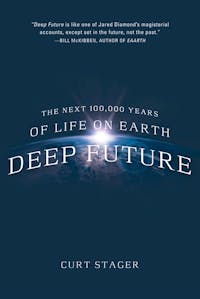Deep Future
The Next 100,000 Years of Life on Earth
 Download image
Download image
ISBN10: 0312614632
ISBN13: 9780312614638
Trade Paperback
304 Pages
$19.99
Imagine a world where North American and Eurasian navies are squaring off over shipping lanes through an acidified, ice-free Arctic. Centuries later, their northern descendants retreat southward as the recovering sea freezes over again. And later still, future nations plan how to avert an approaching Ice Age by burning what remains of Earth's fossil fuels.
These are some of the events that human civilization is likely to face in the next 100,000 years. Choices made and actions taken in this century will affect that future more than those of any previous generation. We are living at the dawn of the Age of Humans; the only question is how long that age will last.
Few have yet asked, "What happens after global warming?" Drawing upon the latest, groundbreaking works of a handful of climate visionaries, Deep Future looks beyond A.D. 2100 to the next hundred millennia of life on Earth.
Reviews
Praise for Deep Future
"In his illuminating and unsettling book Deep Future, paleoclimatologist and ecologist Curt Stager argues that, with our collective carbon footprint, we currently define the planet's climate not only for our great-grandchildren but potentially for any creatures living hundred thousand years from now."—Sabine Russ, Bomb
"Deep Future is a clear, concise, and thought provoking work, one that takes a refreshingly frank look at the science behind global warming and, more importantly, what is coming next. In a field where hyperbolic claims and bitter skepticism prevail, the clarity and unflappability of Stager's account is like a breath of fresh, slightly heated air."—The Faster Times
"Amid all the ranting, confusing, and contradicting books on climate change, at last here's one that does something truly useful: Clearly and engagingly, scientist Curt Stager guides us into back into the atmosphere's history, letting us compare it to the present and draw informed ideas about what to expect in the future. It's heartening to know that he expects us to have one."—Alan Weisman, author, The World Without Us
"Deep Future is a richly informative and deeply persuasive book—one that will be relevant for generations."—Elizabeth Kolbert, author of Field Notes from a Catastrophe
"Deep Future is like one of Jared Diamond's magisterial accounts, except set in the future, not the past."—Bill McKibben, author of The End of Nature and Eaarth
"A highly entertaining, carefully balanced, and deeply sobering look at our climate future."—William F. Ruddiman, author of Plows, Plagues, and Petroleum
"Fascinating and measured—at last someone is taking the long view."—Mark Lynas, author of Six Degrees
"This intriguing and thought-provoking view of the far future is an essential read for all interested in the full force of climate change. "—Paul Andrew Mayewski, Director of the Climate Change Institute, and author of The Ice Chronicles
"A probing exploration of the impact of climate change over geological time . . . Essential reading."—Kirkus Reviews (starred review)
"A thoughtful, if controversial, approach to an over-heated subject."—Publishers Weekly
Reviews from Goodreads
BOOK EXCERPTS
Read an Excerpt
1
Stopping the Ice
One can only hope that the expected extremes of the Anthropocene will not lead to conditions that cross the threshold to glaciation.
—Frank Sirocko, paleoclimatologist.
Shockingly...



